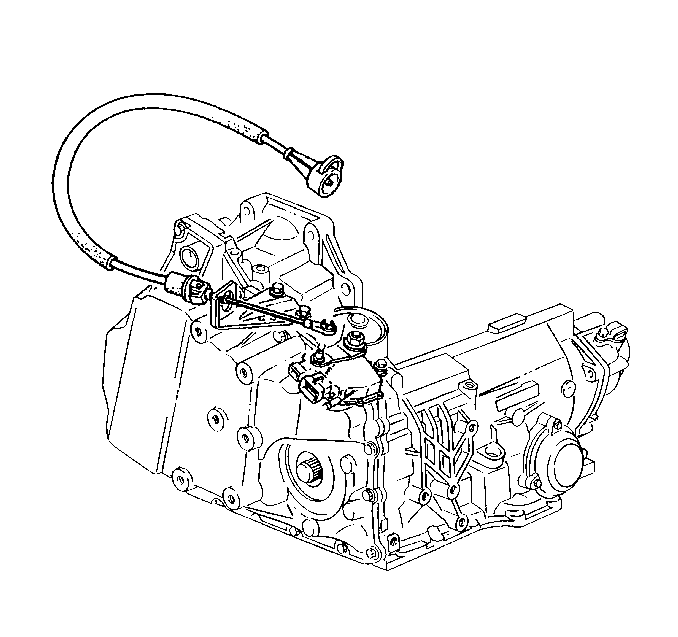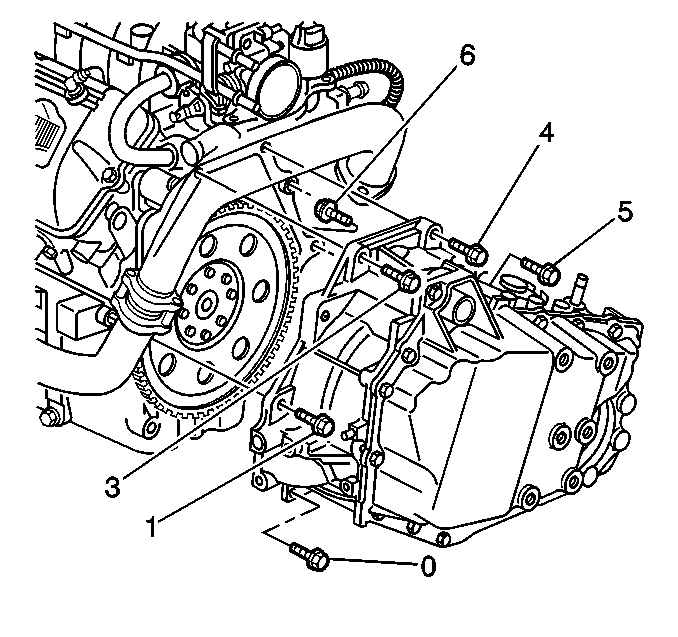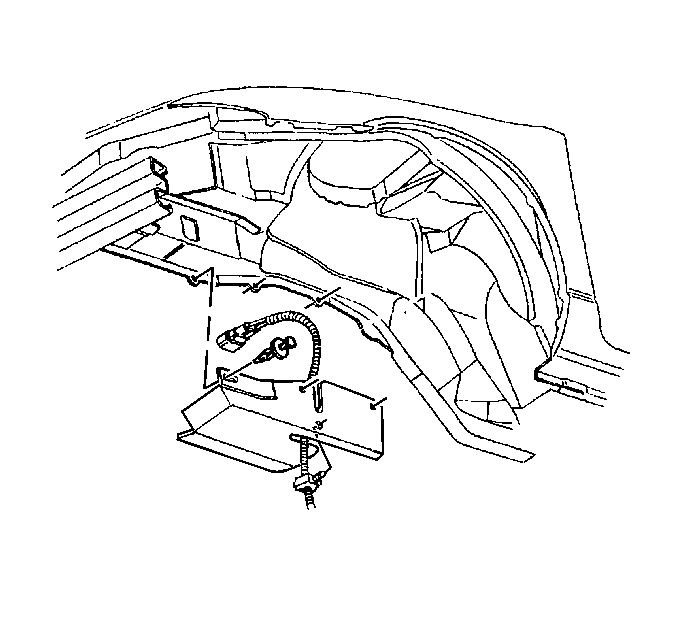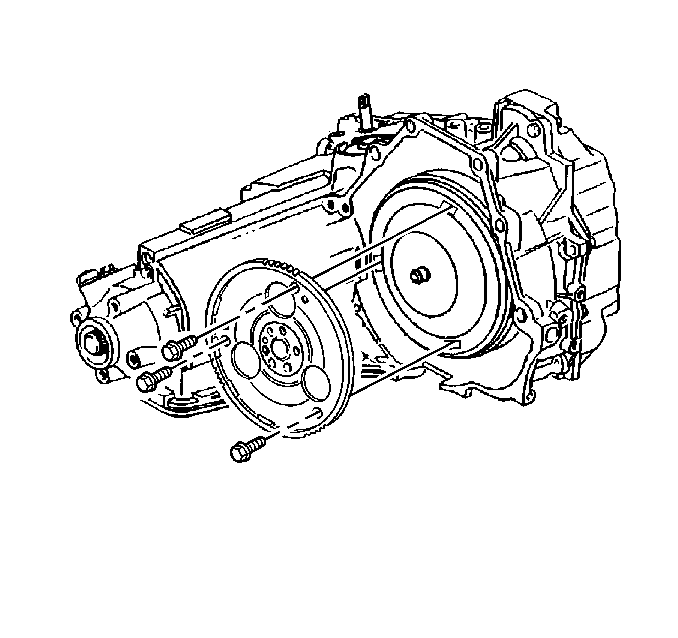Tools Required
| • | J 38778 Door Trim Pad and Garnish Clip Remover |
| • | J 43442 Flywheel Holder |
Removal Procedure
- Disconnect the battery negative cable. Refer to Battery Negative Cable Disconnection and Connection in Engine Electrical.
- Remove the throttle body air inlet duct. Refer to Air Cleaner Inlet Duct Replacement in Engine Controls.
- Disconnect the electrical connectors from the transaxle. Refer to Harness Routing Views in Engine Electrical.
- Remove the transaxle range selector cable retainer from the cable.
- Disconnect the transaxle range selector cable from the transaxle.
- Remove the upper transaxle bolts.
- Remove the wiring harness grounds.
- Install the engine support fixture. Refer to Engine Support Fixture in Engine Mechanical - 3.5L
- Raise and support the vehicle. Refer to Lifting and Jacking the Vehicle in General Information.
- Remove the front wheels. Refer to Tire and Wheel Removal and Installation in Tires and Wheels.
- Use the J 38778 in order to remove the push-in retainers holding the ABS lead to the splash shields.
- Use the J 38778 in order to remove the push-in retainers from the splash shield.
- Remove both the engine splash shields from the vehicle.
- Remove the frame from the vehicle. Refer to Frame Replacement in Frame and Underbody.
- Remove the starter motor. Refer to Starter Motor Replacement in Engine Electrical.
- Use the J 43442 in order to gain access to the torque converter bolts and prevent the flywheel from turning.
- Remove the torque converter bolts.
- Disconnect the transaxle oil cooler pipes from the transaxle. Refer to Automatic Transmission Oil Cooler Hose Replacement .
- Disconnect the wheel drive shafts from the transaxle. Refer to Wheel Drive Shaft Replacement in Wheel Drive Shafts.
- Disconnect the vehicle speed sensor electrical connector. Refer to Vehicle Speed Sensor Replacement .
- Position a transmission jack under the transaxle and secure the transmission jack to the transaxle.
- Remove the transaxle brace. Refer to Transmission Brace Replacement .
- Remove the lower transaxle bolts.
- Remove the transaxle from the vehicle.
- Transfer all necessary parts as needed.
- Flush the transmission cooler and lines. Refer to Transmission Fluid Cooler Flushing and Flow Test .



Important: The transaxle/engine bolts must be returned to their original position. The bolt installed in position number (5) is two millimeters shorter then the other transaxle/engine bolts and requires the use of thread sealant. The bolt installed in position number (3) has a special pilot point.



Important: Position and secure the wheel drive shafts out of the way.
Important: Ensure the transmission jack is properly secured to the transaxle.

Important: The transaxle/engine bolts must be returned to their original position. The bolt installed in position number (5) is two millimeters shorter then the other transaxle/engine bolts and requires the use of thread sealant. The bolt installed in position number (3) has a special pilot point.
Installation Procedure
- Position the transaxle onto a transmission jack and secure the transaxle to the transmission jack.
- Install the transaxle into the vehicle.
- Install the lower transaxle bolts into positions (0,1,3,4, 5 and 6).
- Install the transaxle brace. Refer to Transmission Brace Replacement .
- Use the J 43442 in order to gain access to install the torque converter bolts and prevent the flywheel from turning.
- Install the torque converter bolts.
- Connect the wheel drive shafts to the transaxle. Refer to Wheel Drive Shaft Replacement in Wheel Drive Shafts.
- Connect the transaxle oil cooler pipes to the transaxle. Refer to Automatic Transmission Oil Cooler Hose Replacement .
- Install the starter motor. Refer to Starter Motor Replacement in Engine Electrical.
- Connect the vehicle speed sensor electrical connector. Refer to Vehicle Speed Sensor Replacement .
- Install the push-in retainers holding the ABS lead to the engine splash shield.
- Install the push-in retainers holding the engine splash shields.
- Install the front tires and wheels. Refer to Tire and Wheel Removal and Installation in Tires and Wheels.
- Lower the vehicle.
- Install the torque converter bolts.
- Lower the vehicle.
- Remove the engine support fixture. Refer to Engine Support Fixture .
- Install the upper transaxle bolts into positions (3) and (4).
- Install the transaxle wiring grounds to the transaxle.
- Install the wiring harness connectors to the transaxle. Refer to Harness Routing Views in Engine Electrical.
- Install the automatic transaxle range selector cable to the transaxle.
- Install the automatic transaxle range selector cable retainer to the cable.
- Install the throttle body air inlet duct. Refer to Air Cleaner Inlet Duct Replacement in Engine Controls.
- Connect the battery negative cable. Refer to Battery Negative Cable Disconnection and Connection in Engine Electrical.
- Adjust the fluid level. Refer to Transmission Fluid Check .
- Inspect for fluid leaks. Refer to Fluid Leak Diagnosis .
- Inspect for proper completion of the repairs.
- Inspect the front end alignment. Refer to Wheel Alignment Measurement in Wheel Alignment.
- Reset the TAP values. Refer to Adapt Function .
Important: Ensure the transaxle is secured properly to the transmission jack.
Notice: Refer to Fastener Notice in the Preface section.

Important: The transaxle/engine bolts must be returned to their original position. The bolt installed in position number 5 is two millimeters shorter then the other transaxle/engine bolts and requires the use of thread sealant. The bolt installed in position number (3) has a special pilot point.
Tighten
Tighten the lower transaxle to engine bolts at position (0,1,) and engine to transaxle bolt at position (6) to 75 N·m(55 lb ft).
Tighten
Tighten the lower transaxle to engine bolt at position (5) to 50 N·m (36 lb ft).


Tighten
Tighten the torque converter bolts to 63 N·m (46 lb ft).


Tighten
Tighten the torque converter bolts to 63 N·m (46 lb ft).

Important: The transaxle/engine bolts must be returned to their original position. The bolt installed in position number (5) is two millimeters shorter then the other transaxle/engine bolts and requires the use of thread sealant. The bolt installed in position number (3) has a special pilot point.
Tighten
Tighten the upper transaxle bolts at positions (3) and (4) to 75 N·m (55 lb ft).


Notice: Do NOT overfill the transaxle. The overfilling of the transaxle causes foaming, loss of fluid, shift complaints, and possible damage to the transaxle.
Important: It is recommended that transmission adaptive pressure (TAP) information be reset.
Resetting the TAP values using a scan tool will erase all learned values in all cells. As a result, The ECM, PCM or TCM will need to relearn TAP values. Transmission performance may be affected as new TAP values are learned.